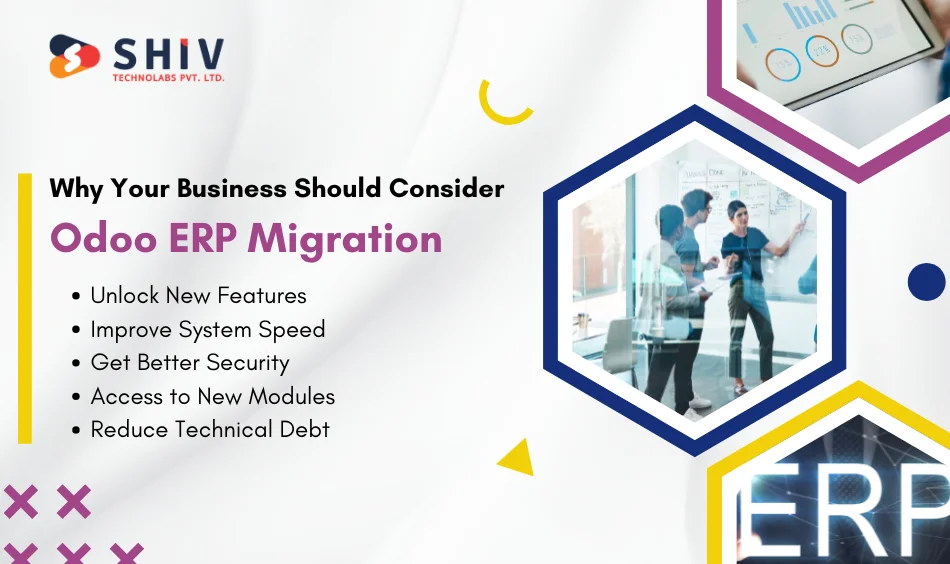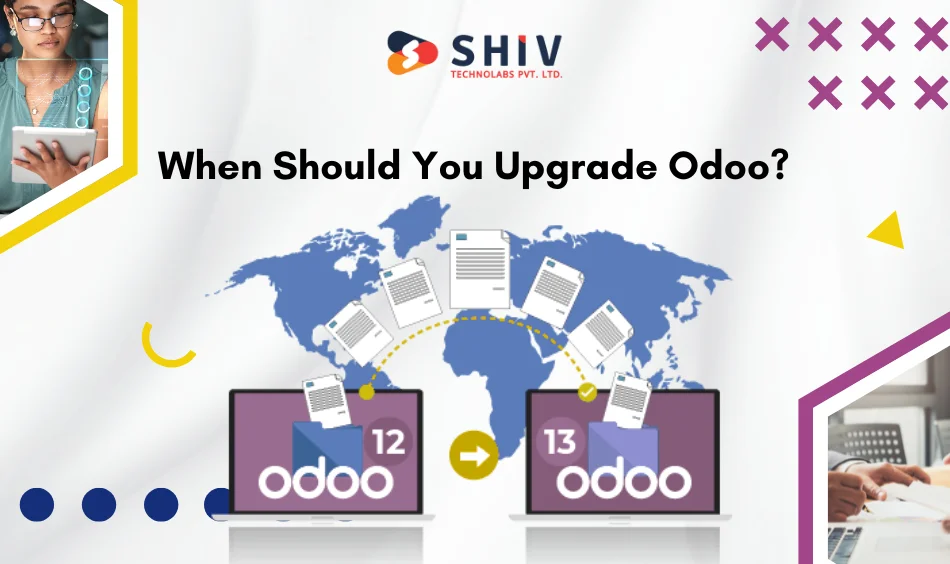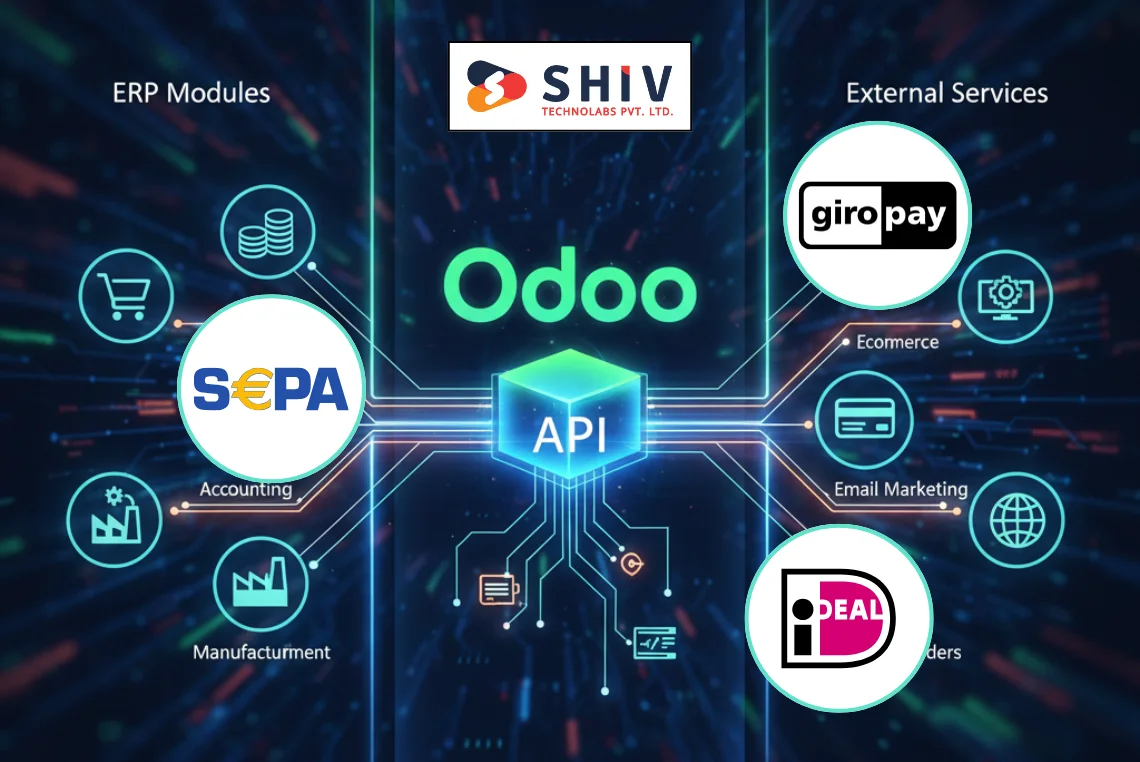Table of Contents
Many companies use Odoo for their daily operations, but they don’t know that their system could work much better. Studies show that more than 30% of companies still use old ERP software versions. They miss out on speed improvements, safety updates, and new tools.
Odoo migration is the process of transferring your existing Odoo ERP to a newer version. You copy all your data, download the latest special add-ons, and ensure that everything functions perfectly in the new system.
Are you still using an outdated Odoo version? Your system is likely running slowly, exhibiting errors, struggling to work well with other programs, and lacking essential features. This creates problems that waste time, create security risks, and negatively impact your business productivity.
This guide explains the Odoo migration, addressing why it’s needed, what gets migrated, and the actual costs involved.
What Is Odoo Migration? A Simple Explanation
So, what is odoo migration? Odoo migration involves upgrading your existing Odoo ERP system to the latest available version of Odoo. It’s not a simple software update—the process has three main parts:
1. Data Migration
Your important business information gets carefully moved to the new system. This includes customer information, sales history, product lists, money records, and everything else your business depends on.
2. Custom Module Migration
Your business likely utilizes specialized Odoo features or additional programs. These need updates to work with the new system structure. This step typically involves modifying code and running tests.
3. Platform Version Change
The central Odoo system receives new features, enhanced security, and improved performance each year. Your system’s foundation gets replaced with the latest version that comes out annually.
Simply put, Odoo ERP migration transfers your business from an outdated, slow, and less secure version to a modern, efficient platform. You keep all your old information and custom settings during this change.
Why Your Business Should Consider Odoo ERP Migration

Here’s why updating to the latest Odoo version matters for your business:
1. Unlock New Features
Each new Odoo release brings many new features. You get better customer management tools, smarter accounting screens, and more. Odoo 17 brought faster point-of-sale systems, new employee management tools, and better online store tracking. Companies using version 13 or older miss all these improvements.
2. Improve System Speed
Old Odoo versions become slower when many people use them simultaneously. Migration makes your system faster. Information searches happen quicker. Pages load faster. Your workers get more done.
3. Get Better Security
Cyber attacks happen more often today. Using old software puts your business at risk. The latest Odoo version features enhanced data protection, improved login systems, and updated connection methods. This keeps your business information safe.
4. Access to New Modules
Odoo keeps growing. New tools for marketing automation, subscription handling, and smart recommendations only work with recent versions.
5. Reduce Technical Debt
Are you still using complicated techniques? Old customizations often break over time. Migration enables you to start fresh, refine your code, and align your ERP system with current best practices.
Odoo ERP migration benefits both the technology you’re using and your entire business.
What Gets Migrated During the Process?
When companies consider migration, they worry about losing their data.
You won’t lose data if the migration is done correctly. Here’s what typically moves to the new system:
| Component | Description |
|---|---|
| Customer Data | Names, emails, purchase history, and contacts |
| Sales Records | Quotations, invoices, and payment status |
| Product Info | Catalog, SKUs, inventory levels |
| Custom Modules | Any tailor-made apps or workflows |
Odoo Data Migration
Everything in your current database gets moved. Information gets cleaned, checked, and transferred to the new system without damage.
Odoo Custom Module Migration
Most businesses modify Odoo to suit their specific needs. These changes often stop working when new versions are released. During Odoo custom module migration, they are updated, rewritten, or replaced to ensure they work with the latest version.
Limitations to Watch For
Some additional programs from the Odoo App Store may not function properly with the latest version of Odoo. You may need to explore alternative options or rebuild certain features.
This is why careful planning and testing are essential before switching to the new system.
When Should You Upgrade Odoo? These Clues Make It Clear

Are you unsure whether to upgrade now? Watch for these warning signs:
1. Frequent Errors and Bugs
When your team encounters problems during routine work, your current version becomes too outdated.
2. Slow Performance
Slow invoice creation, laggy dashboards, and lengthy page loading times indicate that your system infrastructure is outdated.
3. App Compatibility Issues
Some programs may have stopped working or are no longer supported. Your system is indicating that an update is needed.
4. Outdated User Interface
Earlier models appear and feel dated. The new one is cleaner, faster, and better to use on phones. This gives your staff a better work experience.
5. No Vendor Support
Odoo only helps with the last three major versions. If you use version 12 or earlier, official support might not be available.
Should you upgrade Odoo? The answer is yes if you want fewer problems and more features.
Also Read: How to Migrate Odoo Community Database to Cloud?
What Does Odoo Migration Cost?
The price of Odoo ERP migration depends on several things. Here’s how costs break down:
1. Version Gap
The process of migration from Odoo 13 to 17 is more complicated than from Odoo 16 to 17. Skipping more versions means more rebuilding work is required.
2. Number of Modules
More modules mean more testing, more compatibility checking, and more customization work.
3. Database Size
A company with 10 years of business data needs more work for checking, organizing, and moving than one with 6 months of data.
4. Customization Level
Heavily customized systems are harder to move. Every line of custom code needs review or rewriting for the new version.
Estimated Cost Range
- Small businesses with minimal customization: ~$2,000–$4,000
- Mid-sized businesses with moderate modules: ~$5,000–$7,500
- Large-scale systems with high custom code: $10,000+
You can simplify the journey by consulting with a reputable Odoo migration firm, and you may avoid making costly errors.
Do You Need an Expert for Odoo Migration?
Can you handle this yourself? Maybe. Should you try? Probably not.
When DIY Fails
Many teams think migration is easier than it really is. Things may break during work. Information may be lost, there may be a system outage, or you may end up with a non-working system.
What an Odoo Migration Expert Handles:
Data Backup & Validation
Experts ensure that every piece of your information is backed up, checked, and transferred correctly.
Testing & Quality Checks
They test business processes, run user acceptance testing, and verify that all modules work together seamlessly.
Code Refactoring
Old code gets cleaned up. Problems get fixed. This improves your system’s performance on the new version.
Getting an Odoo ERP developer isn’t an extra spending—it’s protection for your business operations.
Final Thoughts
Odoo migration is more than updating your technology. It’s about preparing your business for the future.
You get faster speed, better safety, cleaner screens, and new tools that make your business smarter. You also avoid problems associated with outdated software, such as errors, downtime, and lost productivity.
Don’t wait until your system breaks or loses support. Plan your upgrade. Get help from experts. And use the full power of the latest Odoo version.
Need Help Migrating Odoo Without Losing Data?
Shiv Technolabs offers comprehensive Odoo ERP migration services for businesses of all sizes. If you are migrating to Odoo 11 or Odoo 16, our certified professionals will ensure that the transition is error-free, safe, and rapid.
As an Odoo development company, We handle custom module migration and legacy version upgrades while keeping your data safe and workflows uninterrupted.
Visit Shiv Technolabs to book your Odoo migration consultation today. Your system needs an upgrade. Make it worthwhile with experts.






















